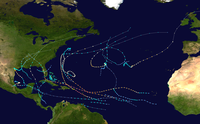
Photo from wikipedia
Secondary cyclones are those that form in association with a pre‐existing primary cyclone, typically along a trailing cold front. In previously studied cases they have been shown to cause extreme… Click to show full abstract
Secondary cyclones are those that form in association with a pre‐existing primary cyclone, typically along a trailing cold front. In previously studied cases they have been shown to cause extreme damage across Europe, particularly when multiple cyclones track over the same location in rapid succession (known as cyclone clustering). To determine the dynamical relationship between primary and secondary cyclones over the North Atlantic, a frontal identification algorithm is partnered with a cyclone identification method to objectively identify secondary cyclones in 35 extended winter periods using reanalysis data. Cyclones are grouped into “cyclone families” consisting of a single primary cyclone and one or more secondary cyclones. This paper aims to quantify the differences between secondary and primary cyclones over the North Atlantic, and how cyclone families contribute to episodes of cyclone clustering across western Europe. Secondary cyclones are shown to occur most frequently in the central and eastern North Atlantic, whereas primary cyclones are commonly found over the western North Atlantic. Cyclone families have their strongest presence over the North Atlantic Ocean and contribute more than 50% of cyclones over the main North Atlantic storm track. A final category, solo cyclones, which are not associated with cyclogenesis on any connected fronts, are most commonly identified over continental regions as well as the Mediterranean Sea. Primary cyclones are associated with the development of an environment that is favourable for secondary cyclone growth. Enhanced Rossby wave breaking following primary cyclone development leads to an increase in the upper‐level jet speed and a decrease in low‐level stability. Secondary cyclogenesis commonly occurs in this region of anomalously low stability, close to the European continent. During periods of cyclone clustering, secondary cyclones are responsible for approximately 50% of the total number of cyclones. The increase in jet speed and decrease in static stability initiated by the primary cyclones acts to concentrate the genesis region of secondary cyclones and direct the cyclones that form along a similar track. While there is an increase in the secondary cyclogenesis rate near western Europe during periods of European clustering, the basin‐wide secondary cyclogenesis rate decreases during these periods. Thus the large‐scale environment redistributes secondary cyclones during periods of clustering rather than increasing the total number of secondary cyclones.
Journal Title: Quarterly Journal of the Royal Meteorological Society
Year Published: 2020
Link to full text (if available)
Share on Social Media: Sign Up to like & get
recommendations!